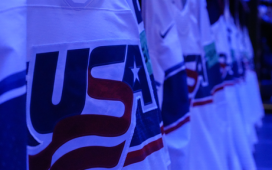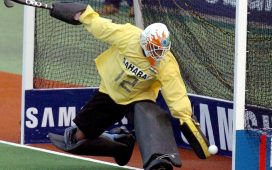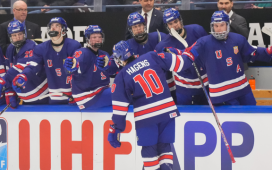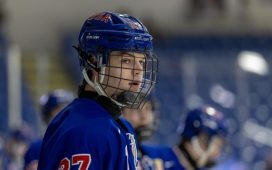The 2019-20 season was already disastrous enough for the Buffalo Sabres, who, for the second consecutive year, wasted a piping-hot start and missed the playoffs. Buffalo sat first overall in the NHL standings as late as Nov. 27 in 2018-19 and, this season, opened with an 8-1-1 run under new coach Ralph Krueger. Eventually, their lack of depth behind star scorer Jack Eichel left them exposed, they sank in the standings, and they extended the league’s longest active playoff drought to nine seasons.
Then came Eichel’s comments during quarantine about being “fed up with the losing.” Then came June 16, 2020, when owners Terry and Kim Pegula axed GM Jason Botterill three weeks after giving him a vote of confidence. The Pegulas have since chainsawed the organization, firing 22 hockey-department employees, leaving behind a husk led by first-time GM Kevyn Adams and director of analytics Jason Nightingale. Buffalo reduced its scouting staff from 21 to seven.
We know the decisions have been at least partially money-motivated, with the Pegulas trimming salaries for a team that won’t compete until at least January 2021. But the on-ice product was also responsible for heads rolling. What went so sideways after such a promising start this season? The Sabres (30-31-8) are next up in our look at the 2019-20 season’s seven eliminated teams.
WHAT WENT WRONG
Botterill didn’t move mountains in the off-season. He made a few promising changes, trading for defensemen Henri Jokiharju and Colin Miller and adding some veteran forward depth in Jimmy Vesey and Marcus Johansson. But the Sabres, breaking in a new coach, were in tough from day 1 to make the playoffs in a top-heavy Atlantic Division that boasted the reigning Presidents’ Trophy winner in Tampa Bay and the reigning Eastern Conference champion in Boston.
To inch to the playoff bubble, the Sabres needed strides from their youth movement. Aside from breakout rookie Victor Olofsson, it didn’t happen. Center Casey Mittelstadt’s confidence shrunk to the point he wound up demoted to the AHL. The Sabres are still feeling the effects of trading Ryan O’Reilly and counting on Mittelstadt to become a reliable No. 2 pivot behind Eichel. It just hasn’t happened yet, and Buffalo’s other top prospect up the middle, 2019 draftee Dylan Cozens, sustained a thumb injury in development camp that required surgery and cost him a chance to compete for a roster spot. Blueliner Rasmus Dahlin remains a phenom in the making, already a two-year veteran before he turned 20, but his sophomore year wouldn’t qualify as a major step forward. He was insulated at just 19:18 of ice time per game after topping 21 minutes as a rookie, and he managed just four goals in 59 games. He piled up assists, but most of his individual offensive metrics regressed in year 2, when he also missed time with a concussion. Dahlin did improve defensively, however. He didn’t have a bad year. He was merely “very good for a 19-year-old” and would’ve had to be elite for the Sabres to make the playoffs.
Dahlin wasn’t the only one who struggled to find the net. The Sabres in general had trouble, icing the league’s 21st-ranked offense. Even though Olofsson’s 20 goals in 54 games were a nice surprise, they couldn’t offset left winger Jeff Skinner tumbling from 40 to 14 goals – after signing an eight-year extension at a $9-million AAV. That was arguably the most catastrophic element to Buffalo’s season. Skinner continued a bizarre career pattern of wildly inconsistent scoring. His goals by year: 31, 20, 13, 33, 18, 28, 37, 24, 40, 14.
With Skinner’s game tanking, the Sabres were too top heavy offensively, with just five players reaching double digits in goals and no defenseman topping six goals. At 5-on-5, only the Detroit Red Wings attempted fewer shots or generated fewer scoring chances per 60 minutes. If you stopped the top line of Olofsson, Eichel and Sam Reinhart, you beat Buffalo, period.
WHAT WENT RIGHT
The Sabres’ deepened D-corps actually made an impact. Buffalo was much closer to average than bad defensively. Jokiharju showed promise in a limited role, and even the maligned Rasmus Ristolainen accomplished a career first: at 5-on-5, his goal differential was even. In his six previous seasons, it sat between minus-10 and minus-27. On the whole, the Sabres allowed the fifth-fewest shot attempts and ninth-fewest scoring chances per 60 minutes and had the 11th-lowest expected goals against per 60. They got adequate goaltending, not so much from Carter Hutton but from Linus Ullmark, who posted a respectable .915 save percentage on the year.
There was nothing wrong with Eichel and his regular right winger Reinhart, either. They and Olofsson combined for 78 goals, more than 40 percent of Buffalo’s total. Reinhart, a pending RFA, topped 20 goals and 50 points for a third consecutive year and has earned himself a major raise over his $3.65-milion cap hit.
TEAM MVP
It’s Eichel by a mile. If Buffalo had sniffed the post-season, Eichel would’ve received a few Hart Trophy votes. His 36 goals were the most by a Sabres center since Chris Drury in 2006-07. Eichel’s 1.15 points per game was the franchise’s highest mark since Danny Briere in 2006-07. Nine of Eichel’s goals were game-winners. He’s becoming the franchise cornerstone he was always supposed to be. His career will be wasted if he doesn’t get some help.
MAJOR MOVES
Getting Jokiharju from the Chicago Blackhawks for Alexander Nylander looked like a smart move for Botterill the day it happened, and that hasn’t changed. The Colin Miller acquisition for a 2021 second- and 2022 fifth-round pick didn’t go as well. He had strong numbers in Vegas but had played extremely insulated minutes. He struggled early on, fell out of favor with Krueger and was a frequent healthy scratch. Miller did get better as the season progressed, and his deeper analytics suggest he should’ve been in the lineup all year.
Botterill’s in-season dealings had an air of desperation to them. He sacrificed mid-round picks in winter trades to land veteran forwards Michael Frolik and Wayne Simmonds. It was bailing water out of a sinking ship at that point.
It will be interesting to see what right winger Dominik Kahun becomes for the Sabres going forward, though. They got him at the trade deadline in a hockey deal sending Conor Sheary and Evan Rodrigues to the Pittsburgh Penguins. In two NHL seasons, Kahun, 24, quietly ranks 30th in first assists per 60 and 66th in points per 60 among 683 NHL skaters with at least 500 minutes played at 5-on-5.
DRAFT DAY
Maybe the Sabres felt comfortable firing scouts because the team won’t be too busy at the podium. It owns just six picks, including two in the final round. The Sabres own a 6.5-percent shot at landing the No. 1 overall selection , and they can pick no lower than ninth overall if non-eliminated teams win all three lottery spots this Friday.
PROSPECTS
When a team goes almost a decade between playoff appearances, you expect them to pile up an impressive list of high-end prospects. But Buffalo’s group doesn’t wow as much as expected. Our panel of active NHL scouts and team executives graded Buffalo’s developmental crop the league’s ninth best in Future Watch 2020. Because the rank includes the organization’s 21-and-younger players at the NHL level, Dahlin and Jokiharju factor in, as does Mittelstadt, who hadn’t yet been demoted at the time we published. If you factor out that trio, Buffalo’s farm crop looks a bit thin. It does have a big, talented pivot on the way in Cozens, who grades out at No. 7 overall in our individual prospect top 100, and Ukko-Pekka Luukkonen, ranked 41st, remains one of the sport’s best goalie prospects despite a season that started late because of hip surgery. The Sabres need to score another top-end prospect, however, and picking in the top 10 at this year’s draft will help.
That said, one reason why the Pegulas probably felt pretty comfortable cleaning out their scouting staff is that the Sabres have just swung and missed with their high picks too often of late. Here are their first- and second-round picks across their past five drafts:
Jack Eichel, 2015
Brendan Guhle, 2015
Alexander Nylander, 2016
Rasmus Asplund, 2016
Casey Mittelstadt, 2017
Marcus Davidsson, 2017
Ukko-Pekka Luukkonen, 2017
Rasmus Dahlin, 2018
Mattias Samuelsson, 2018
Dylan Cozens, 2019
Ryan Johnson, 2019
The 2018 and 2019 picks shouldn’t be considered behind schedule yet, but it’s clear the Sabres aren’t getting the most out of their higher picks unless they’re top-two selections like Eichel, Dahlin or Reinhart (in 2014).
SALARY-CAP SITUATION
Hey, at least Adams has seven months to shape a new roster and a ton of cap space to work with. The Sabres have just four forwards, five defensemen and one goalie signed for 2020-21. Under a flat cap of $81.5 million, they’d have more than $34 million to spend. There will be room to chase upgrades even after forking out cash for RFAs Reinhart, Olofsson, Kahun, Brandon Montour and Ullmark. But given the state of the franchise’s public image right now, it might require overpays to lure any top UFAs.
Also, Dahlin will become eligible to sign an extension this off-season. Given his numbers haven’t reached astronomical excellence yet, the Sabres have a real chance to lock him in on a long-term deal at a bargain price. It worked for the Columbus Blue Jackets with Seth Jones and the Toronto Maple Leafs with Morgan Rielly.
Want more in-depth features, analysis and opinions delivered right to your mailbox? Subscribe to The Hockey News magazine.








